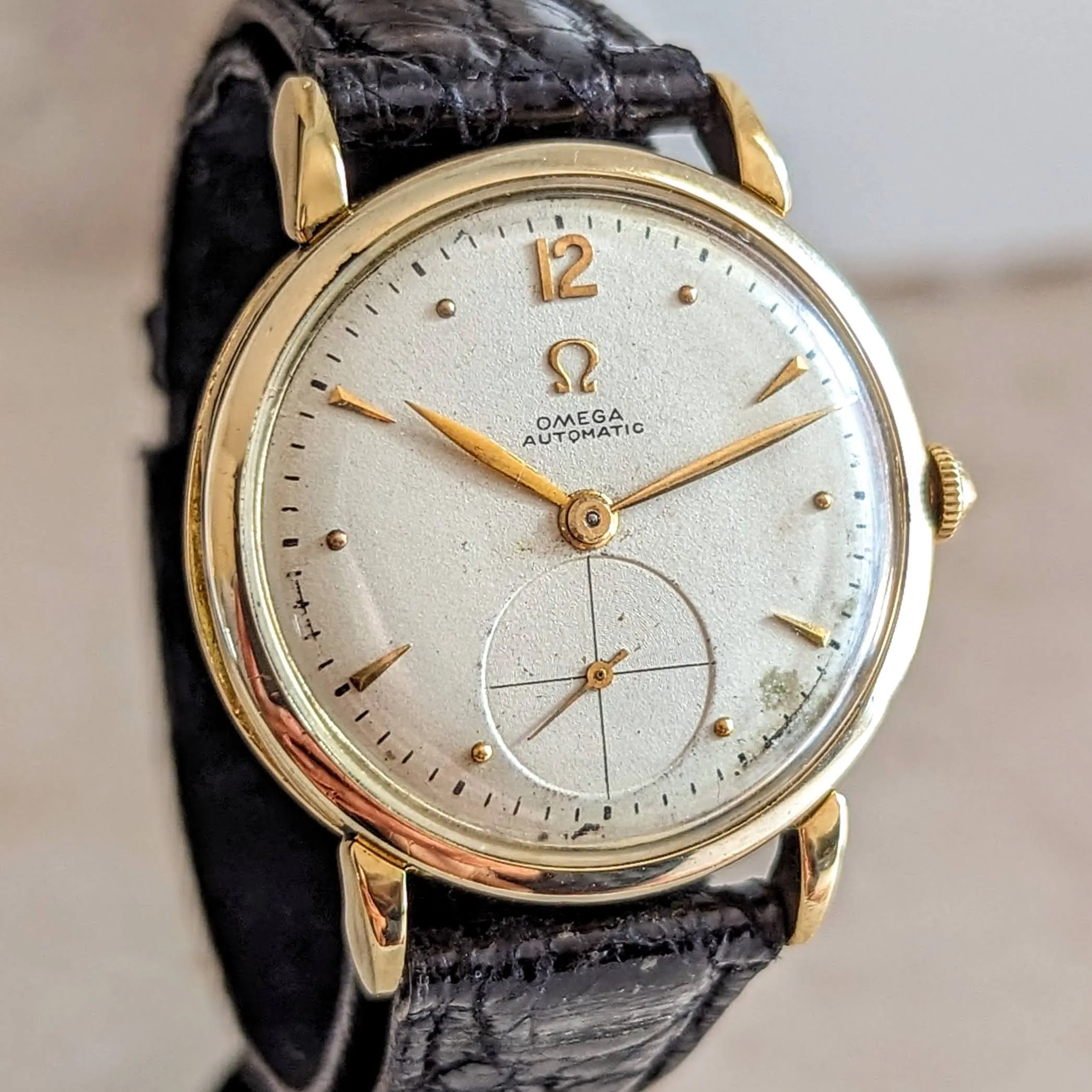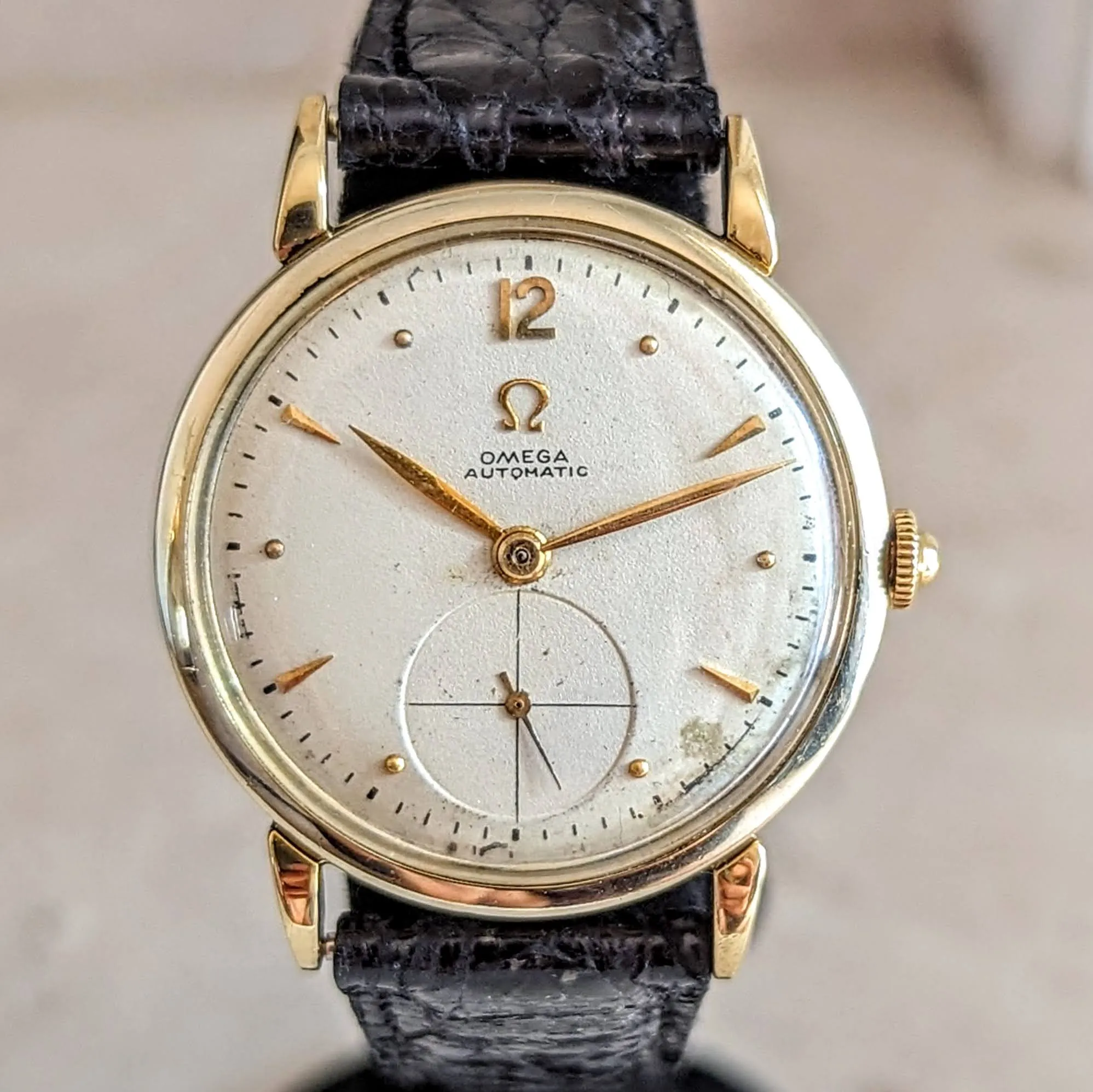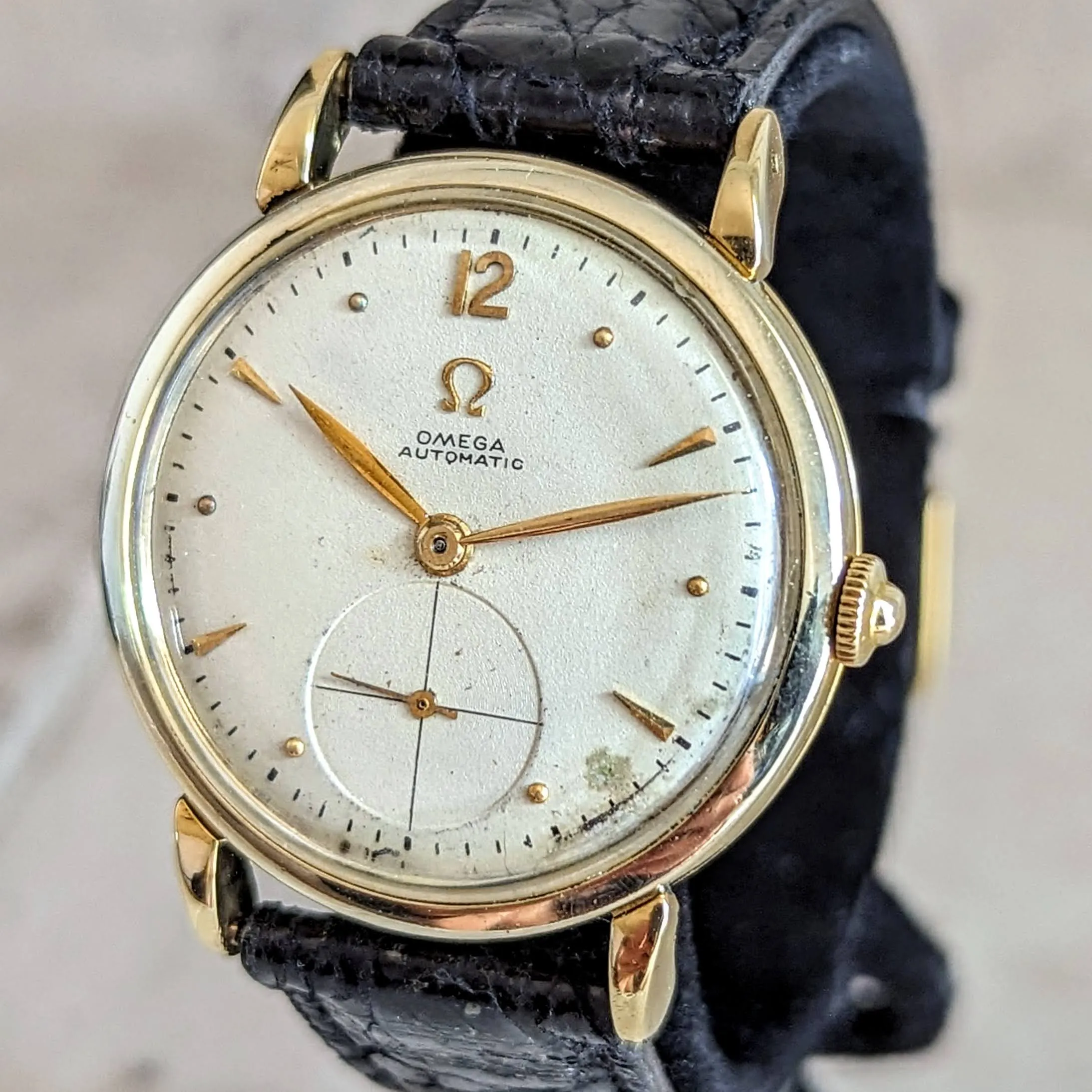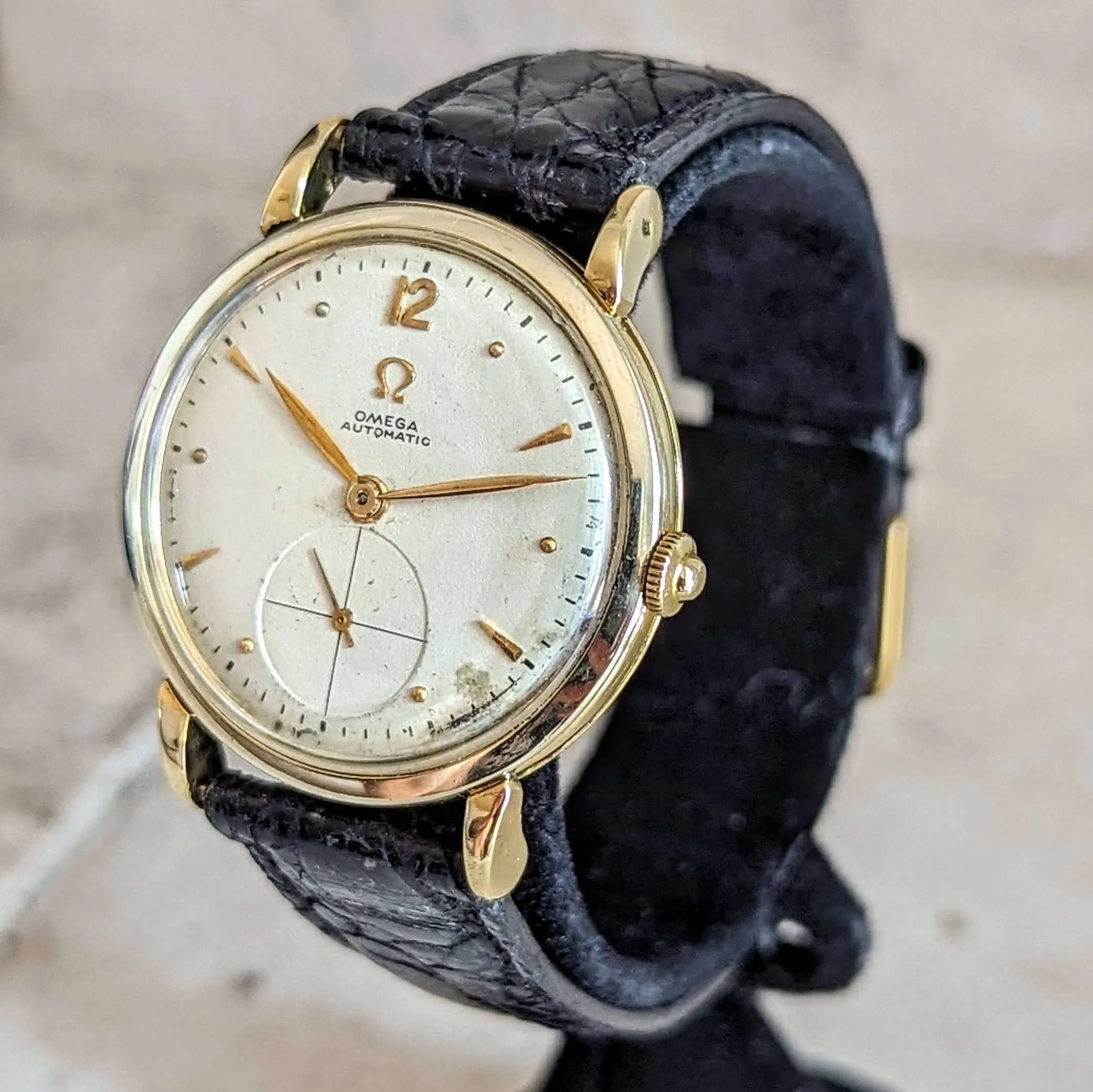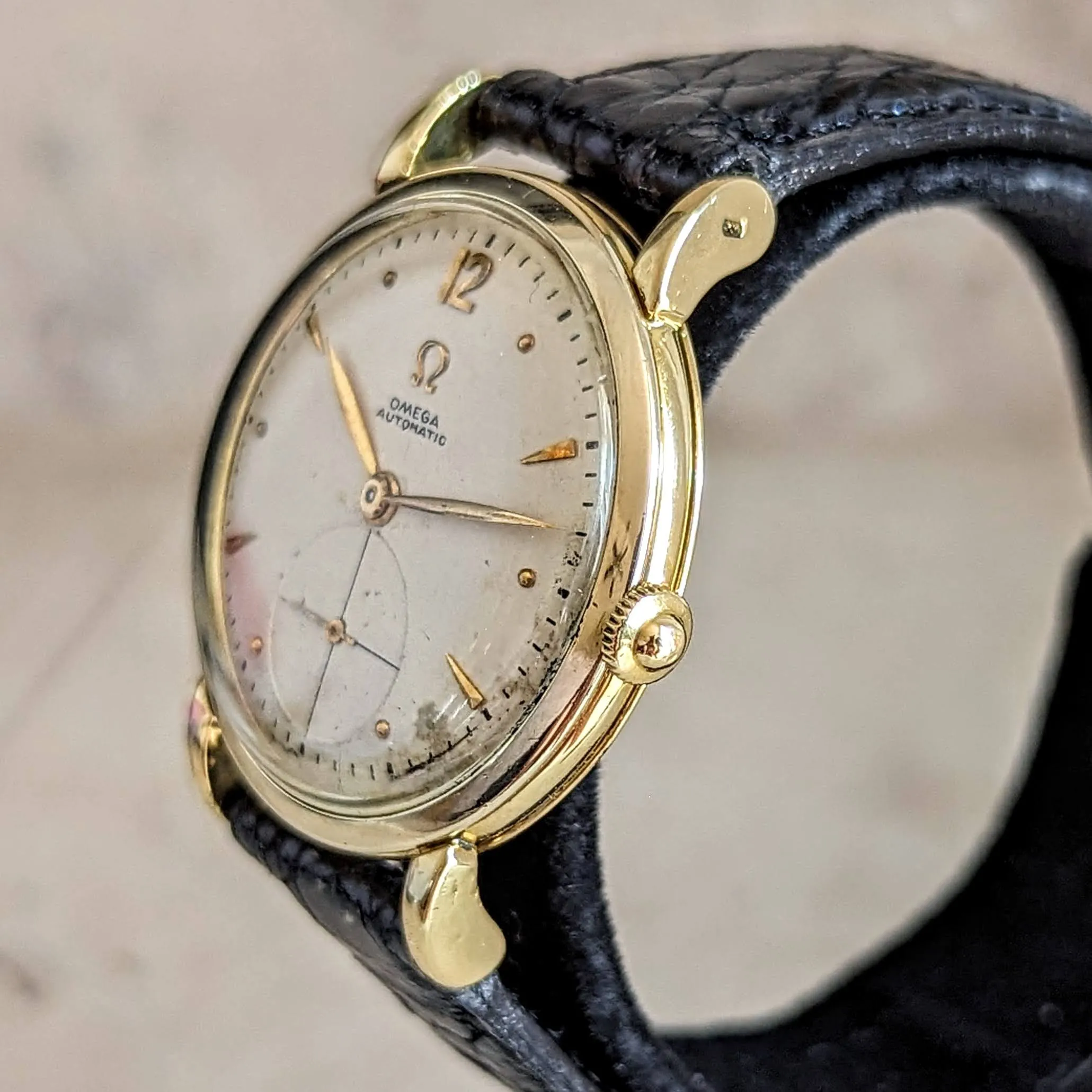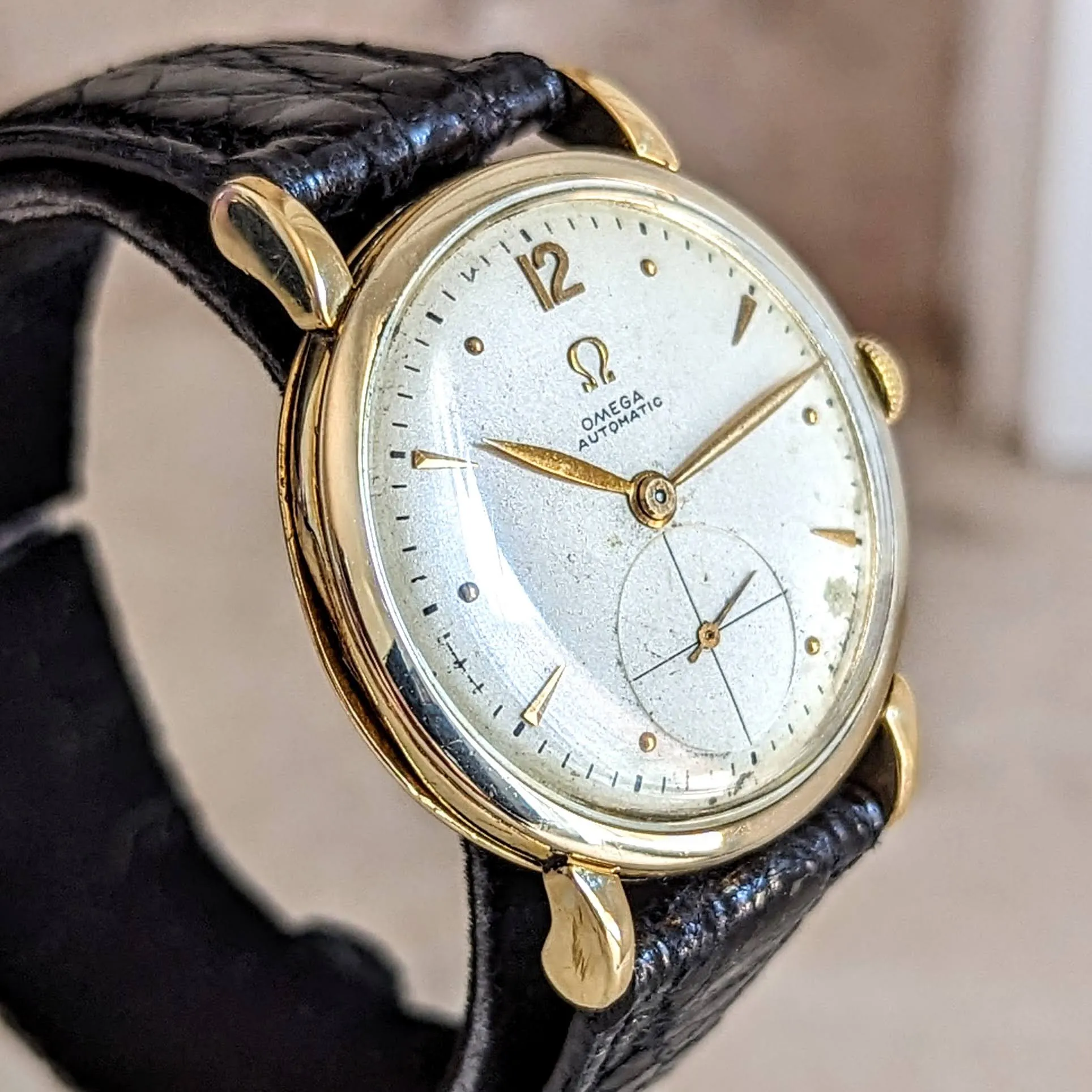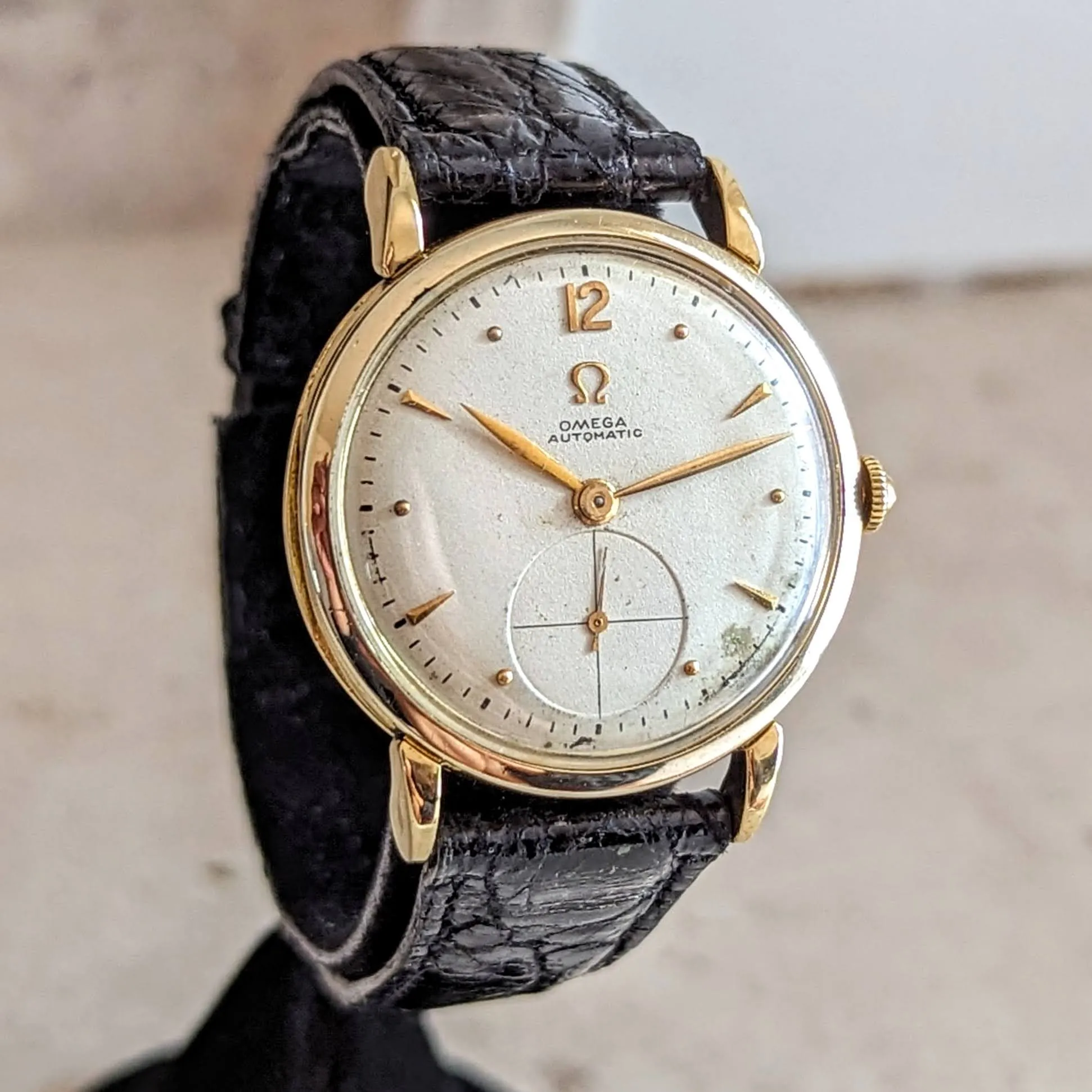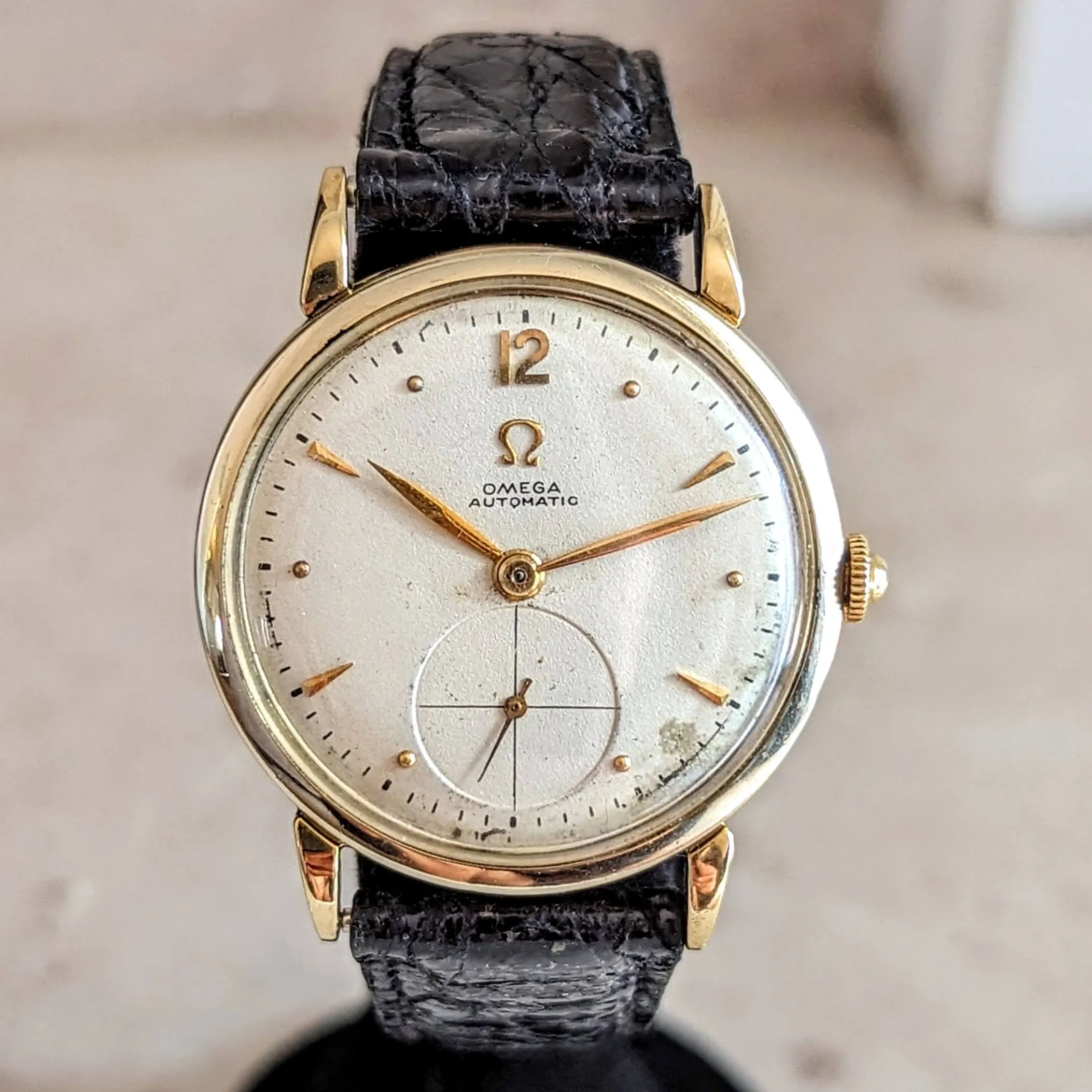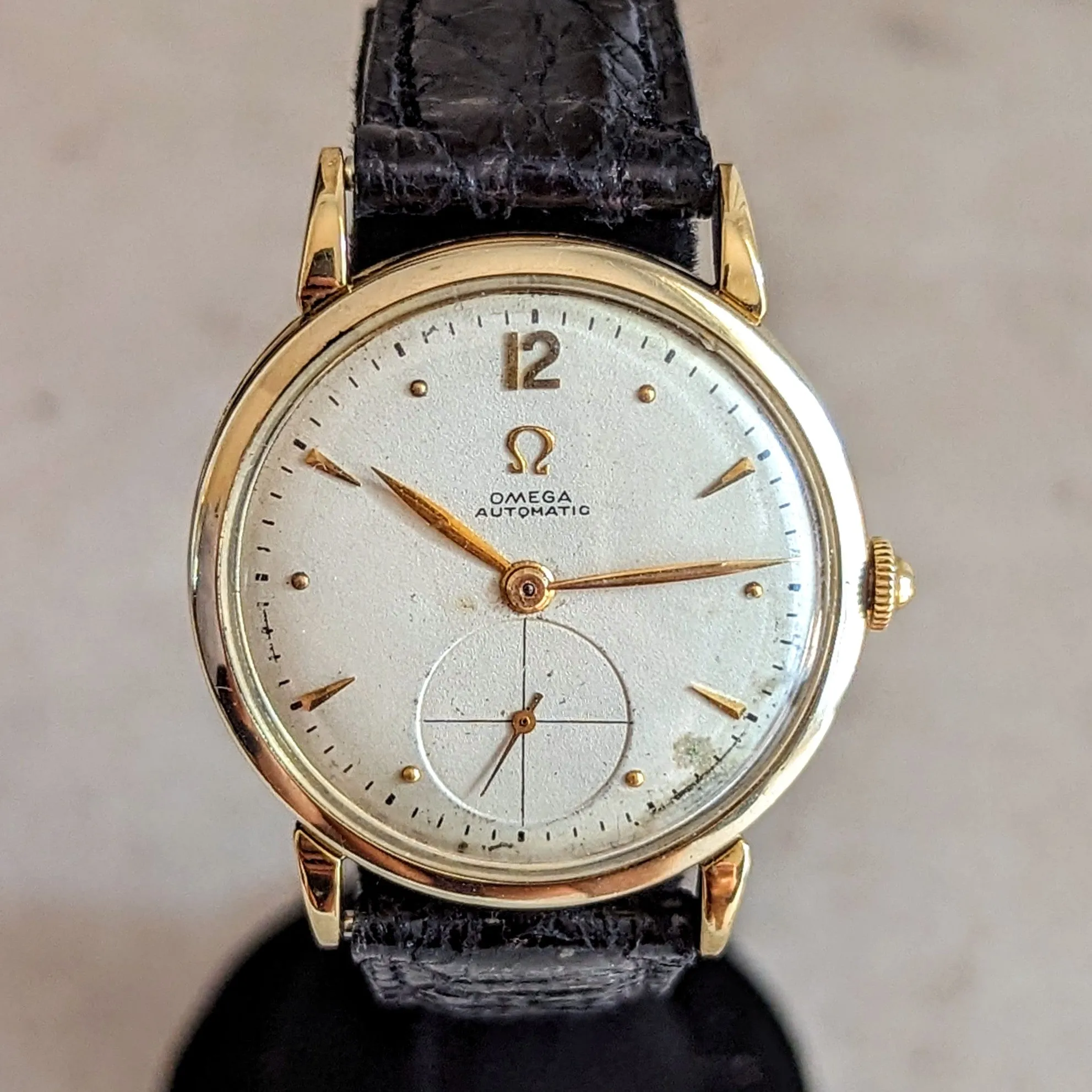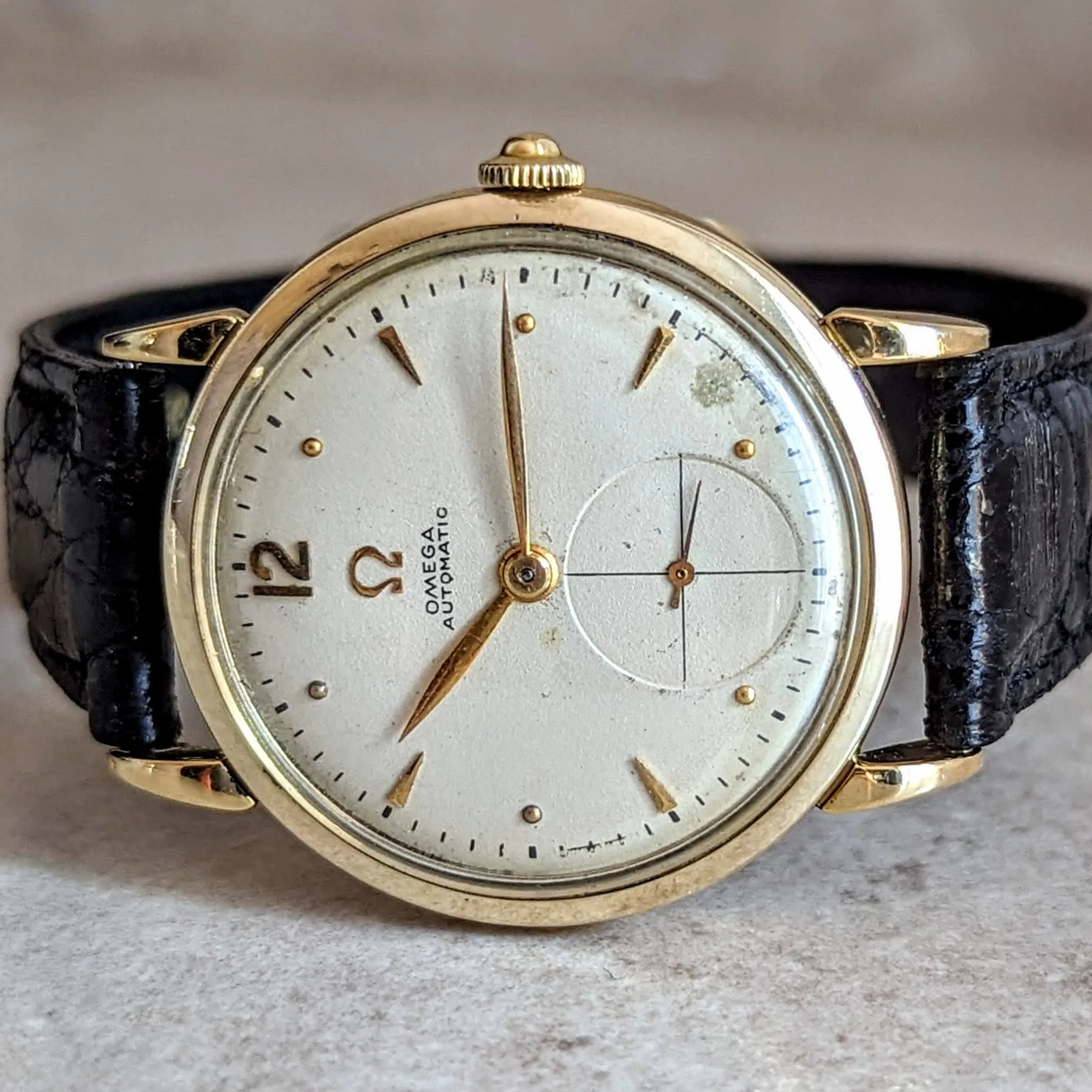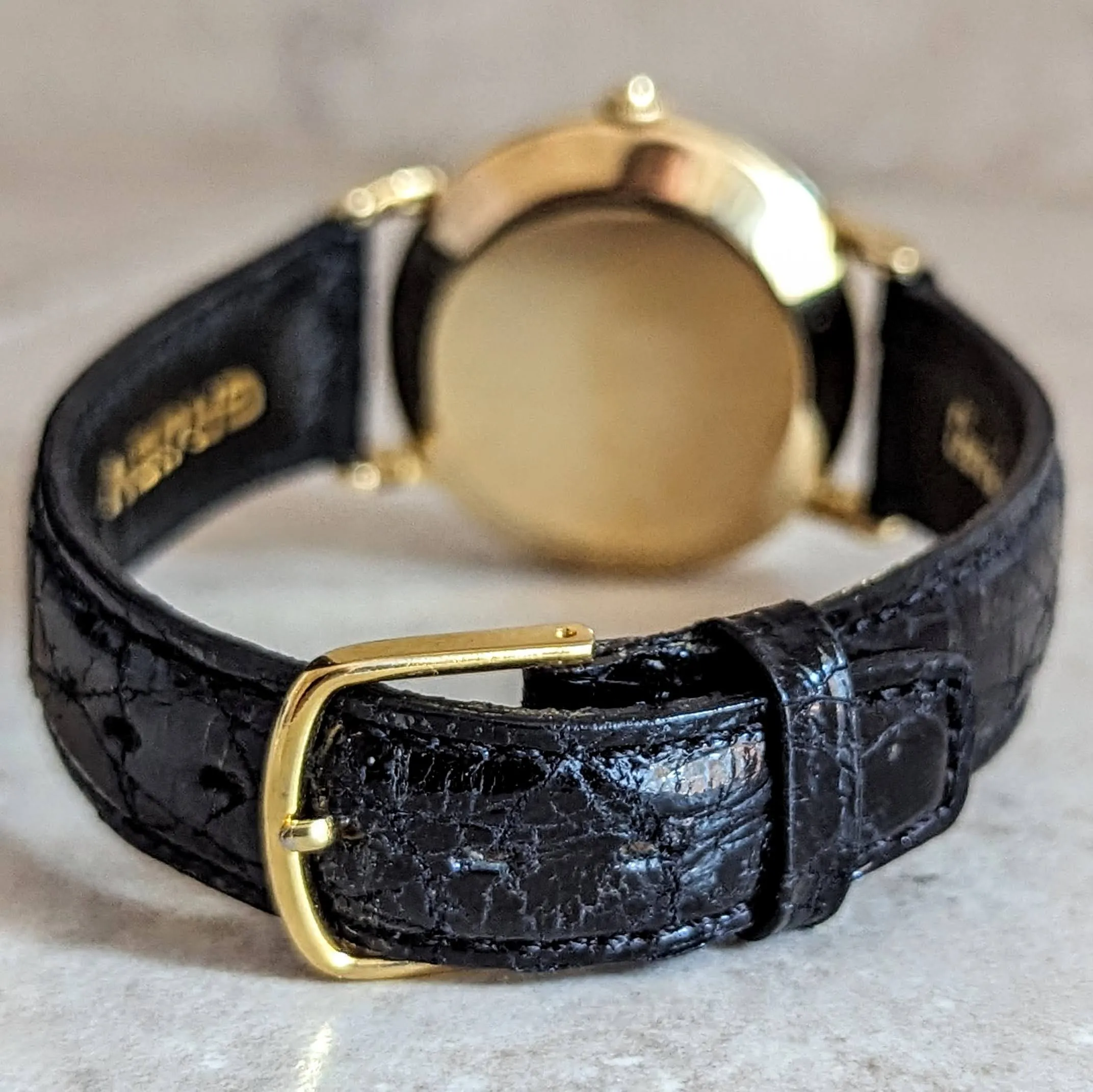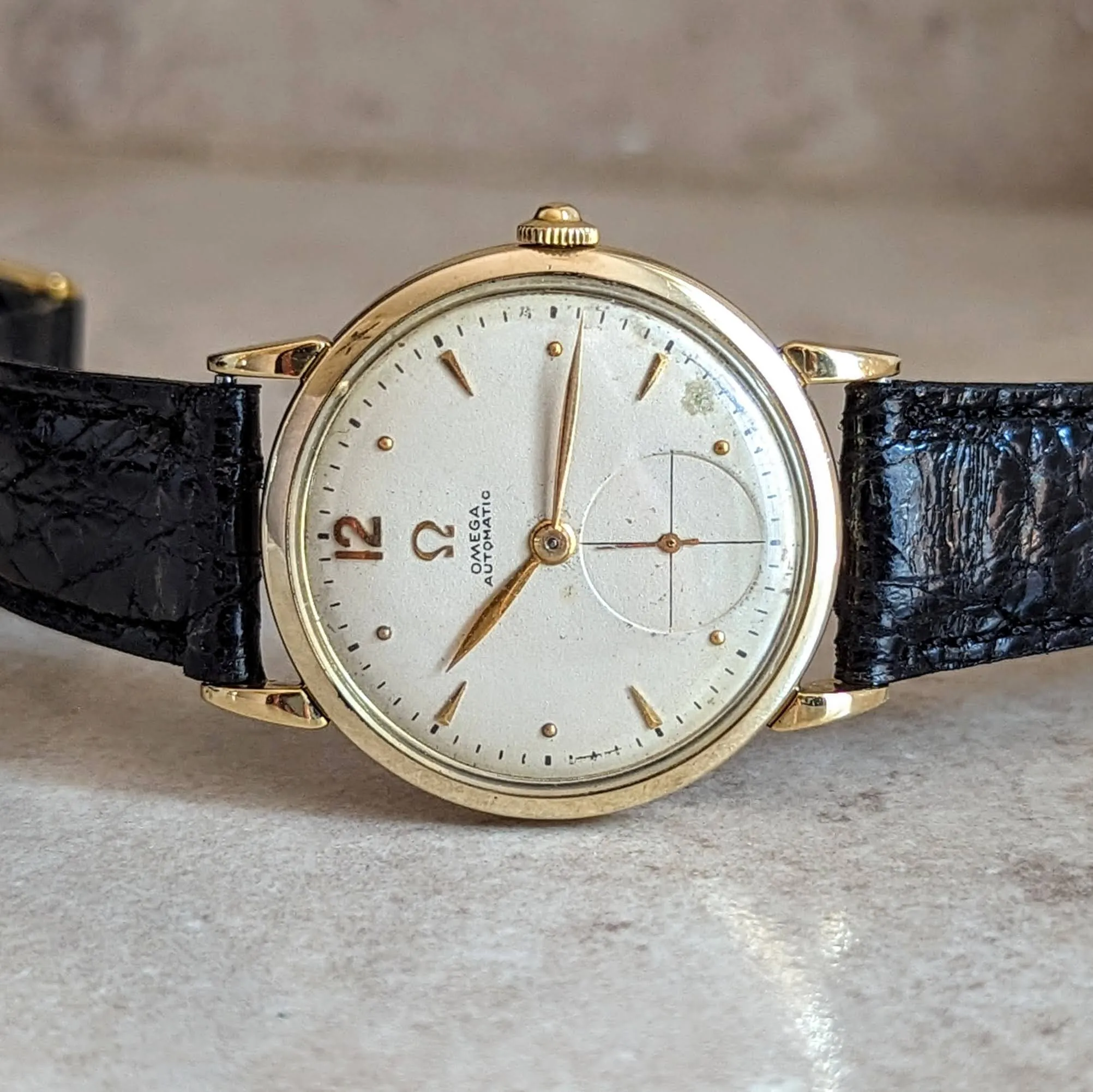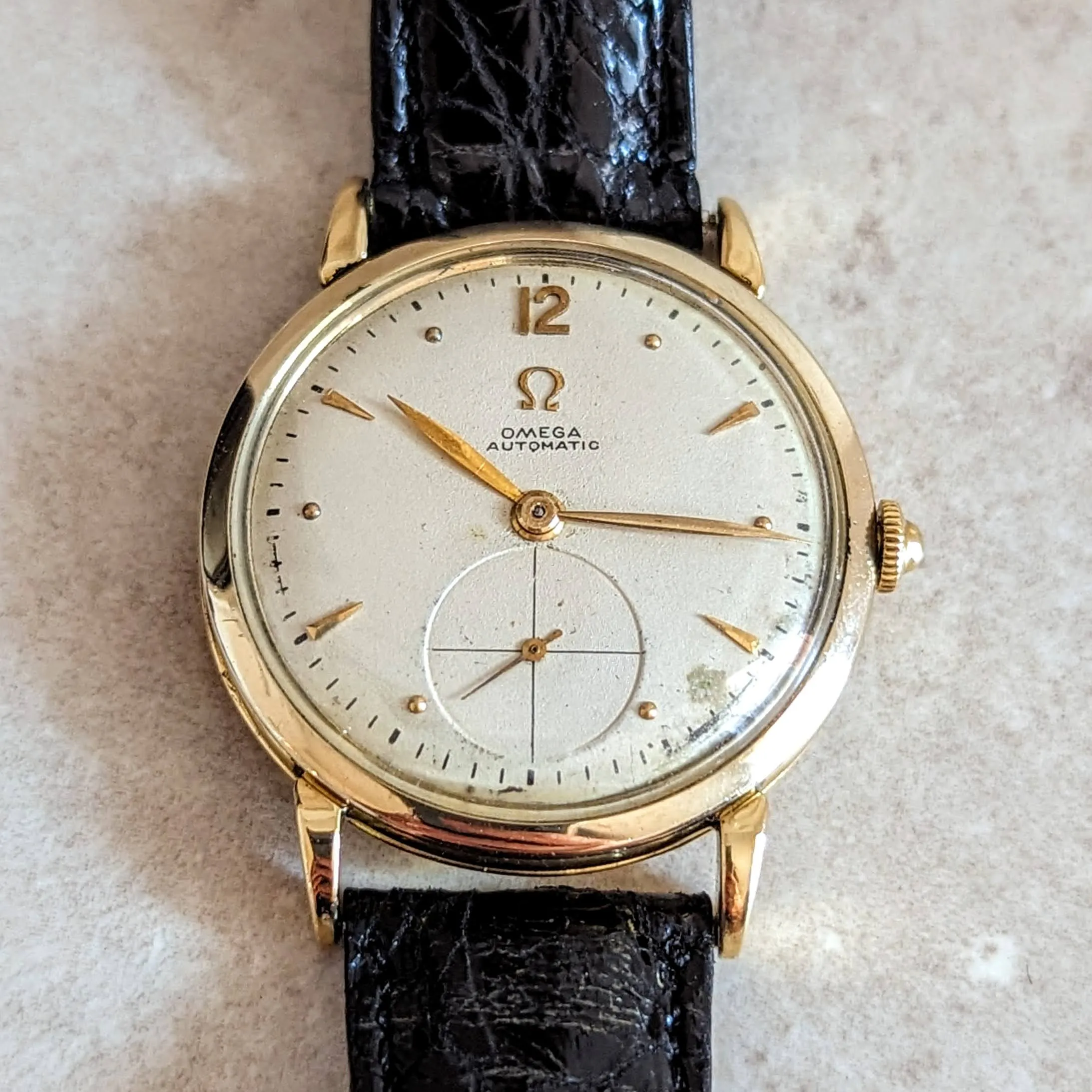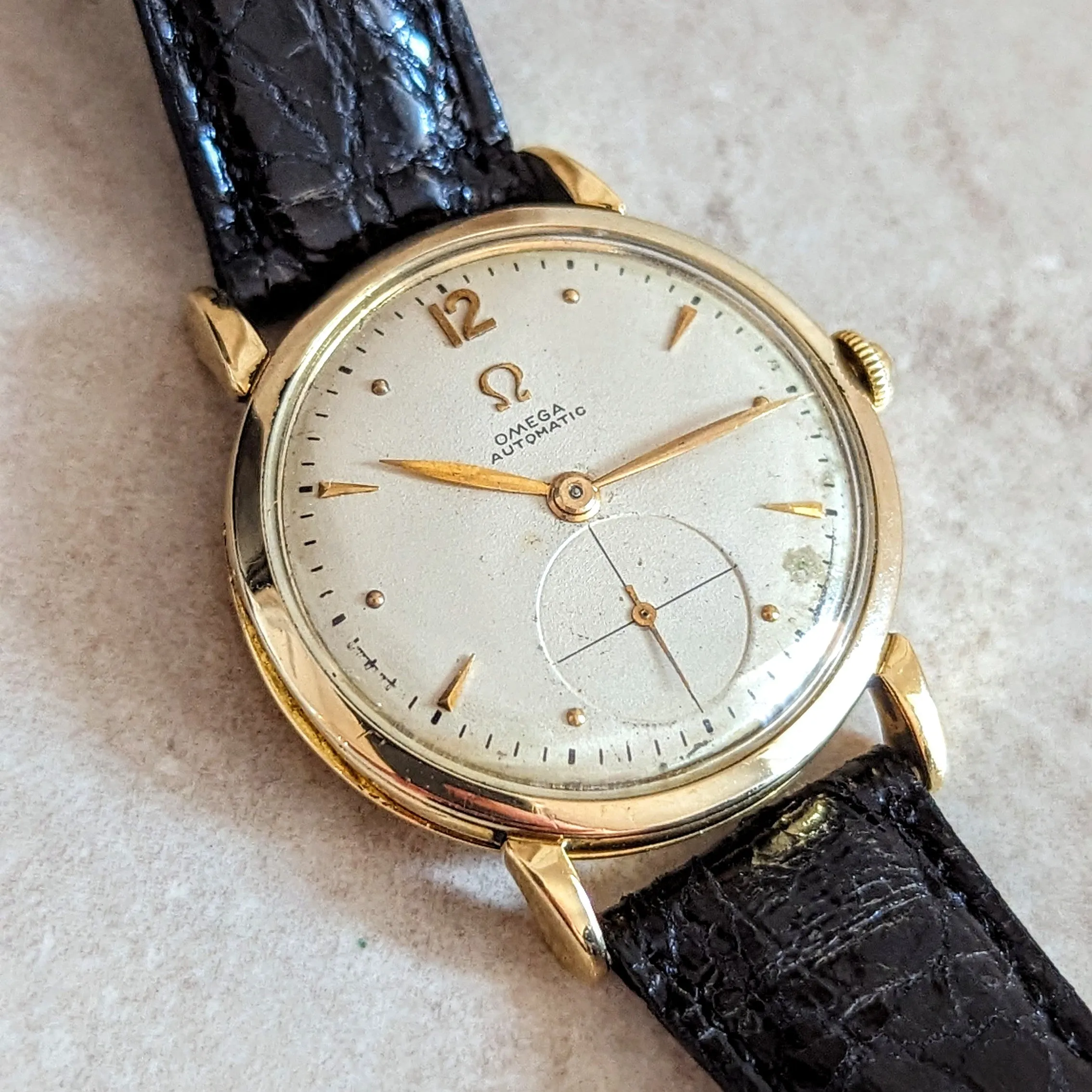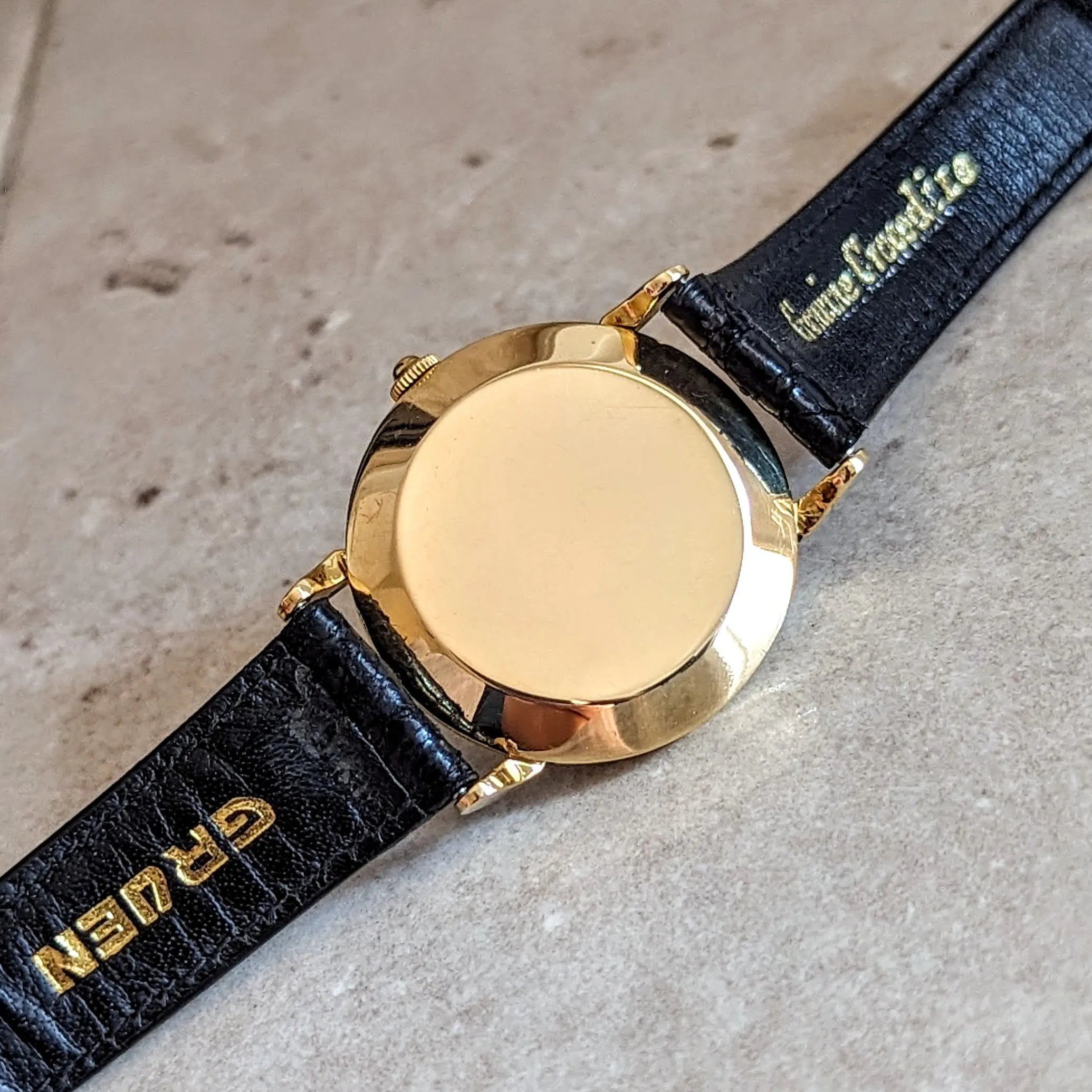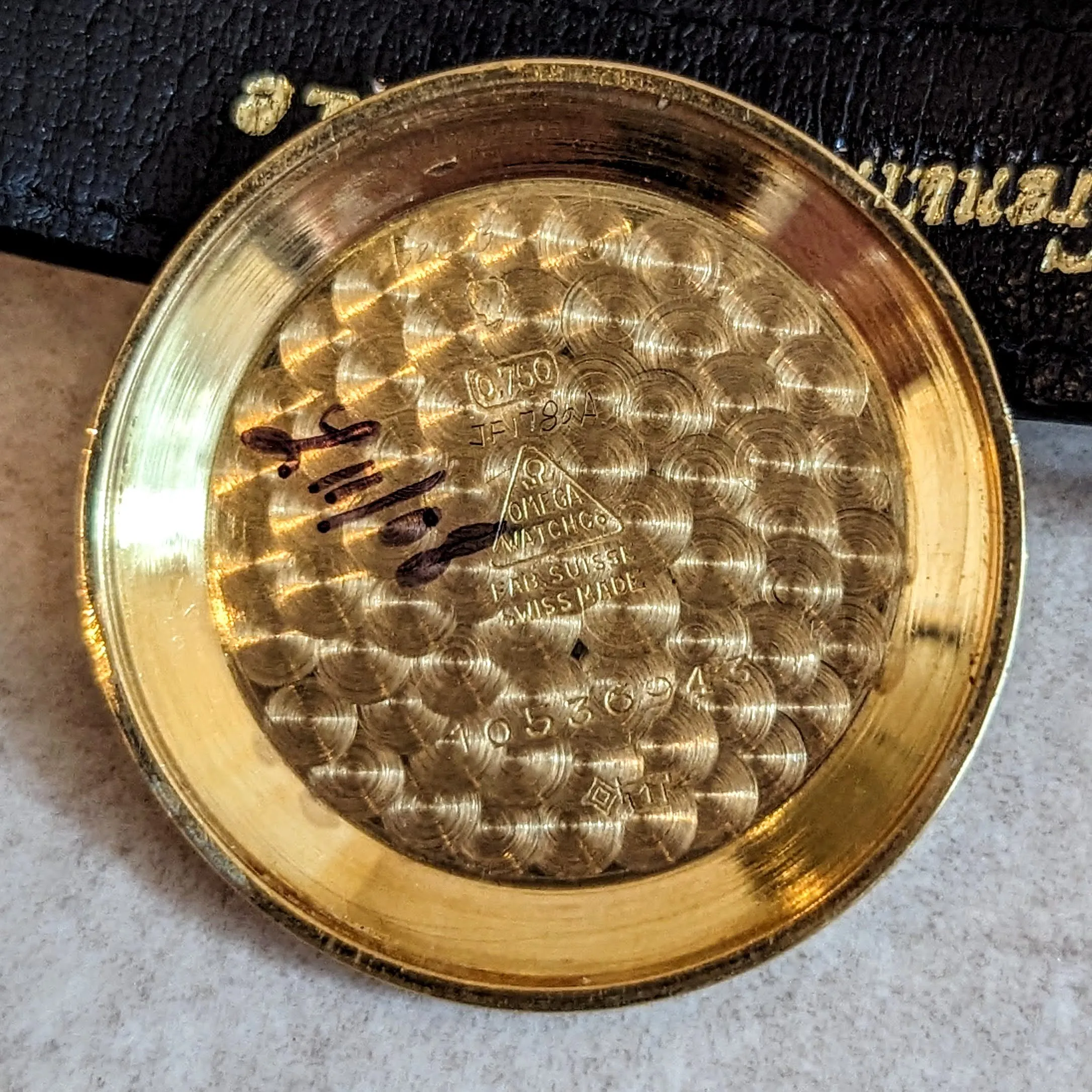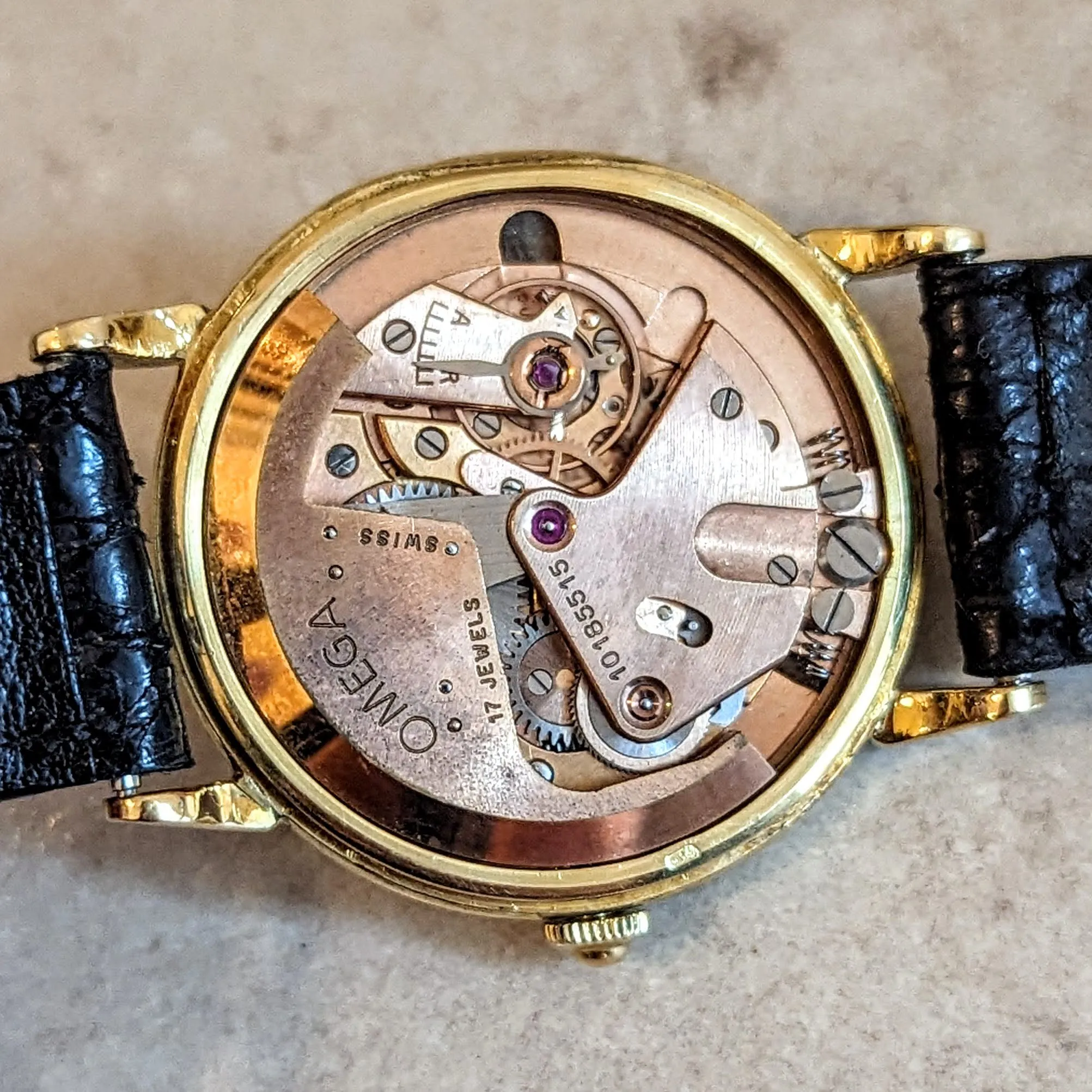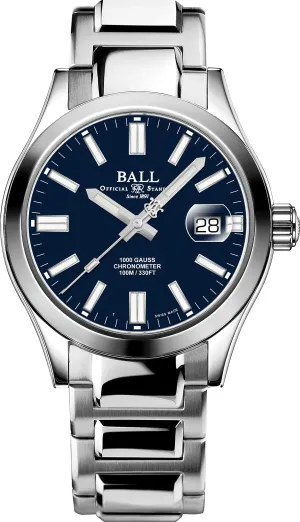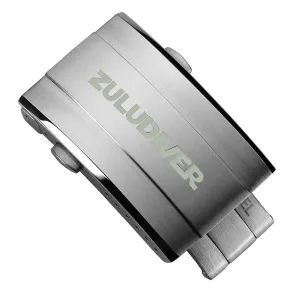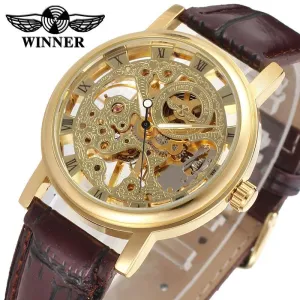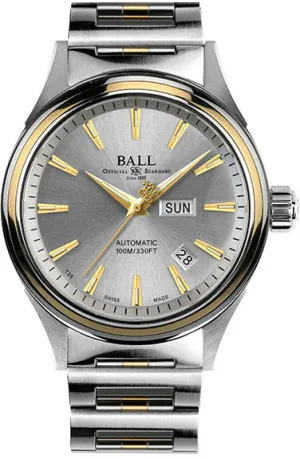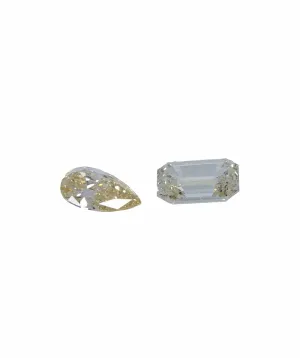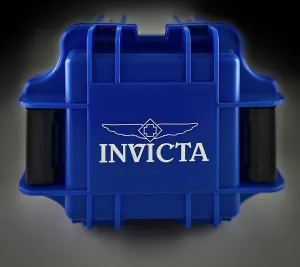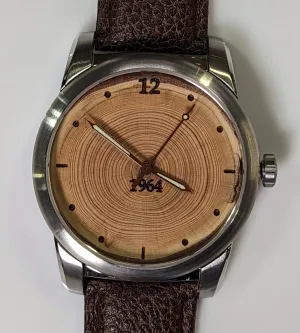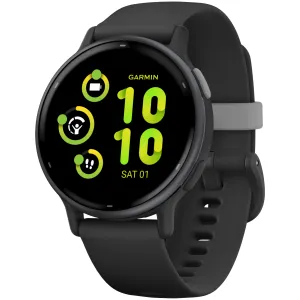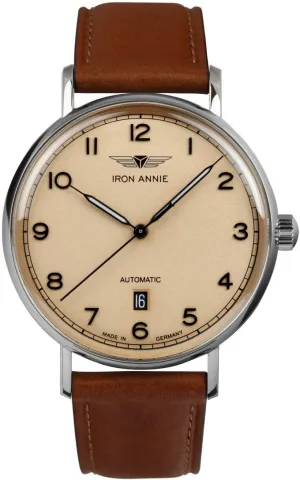Product Details
+
From omegawatches website – “An automatic first 1931. Affecting the design of movement for generations to come, OMEGA prototyped the first automatic movement to use two weights. This new design enabled the winding of the movement in both directions, dramatically improving winding efficiency. What was one a prototype has since evolved to become the industry standard and is still in use today, powering a wide spectrum of mechanical watches.”
AUTOMATIC WATCH MOVEMENT
Self-winding mechanism for automatic watches, a huge development within the horological industry. The Geneva Society of Arts reported in 1777 that “fifteen minutes walking was necessary to wind the watch sufficiently for eight days”, and the following year reported that it was selling well. History says that the invention of the automatic movement dates back to 1777, it also says to have been invented by Abraham-Louis Perrelet (1729 – 1826) – “One of the greatest watchmaking references of all time.” Perrelet was a Swiss watchmaker fascinated by watchmaking professions, as a teenager he devotes himself to the construction of a certain number of precision instruments.
From the 1770s onwards, Abraham-Louis Perrelet applied himself to perfecting a system which, from one single initial impulse, would continue to function indefinitely. It was until 1777 that he develops his completely revolutionary invention: the automatic / self-winding movement. The mechanism transferred the movement of the wearer into energy, using an oscillating weight inside the large watch that moved up and down that powered the timepiece for around eight hours a day. It worked on the same principle as a modern wristwatch, to wind the watch as the owner walks and/or moves.
While Perrelet is thus widely acknowledged as the inventor of the automatic movement, through his invention, a watch movement using a weight pivoting at the side of the movement. In 1778, “the automatic movement was reinvented”, the Belgian clockmaker, watchmaker and a precursor of the industrial age, Hubert Sarton (1748 – 1828) created his version and presented the first drawing and accurate description of an automatic watch movement with a central rotor, then, the design is attributed to him. “It was after the launch of this movement that automatic watches became popular with the general public. People began wearing automatic watches as part of their daily routine.”
No matter how, there is still debates around who first invented the automatic movement. “When Sarton first published his designs in Paris, he claimed that Perrelet was inspired by his designs.”
In a large workshop with numerous employees, Sarton created a variety of timepieces throughout his career, he also concentrated on the production of skeleton clocks in a variety of models – all equally remarkable for their extraordinary quality and diversity. An enlightened man of his time, with a considerable career as a long series of developments, in 1778, Sarton filed a patent at the French Academy of Sciences and become famous for inventing the automatic watch based on a rotor principle. “At once a devoted horologist, mechanic and inventor, Hubert Sarton was one of the major figures of horology in late eighteenth-century Liège.”
Likewise, following the work of Perrelet, other watchmakers also created automatic watches from about 1777 on. However, the automatic watch was popularized by Abraham Louis Breguet’s design. He bought Perrelet’s designs for the automatic movement and worked on these designs to adapt them and make improvements. Breguet’s automatic movement was used in pocket watches. “Unfortunately, his design of the movement was deemed unreliable by many watch wearers. They fell out of popularity with European consumers around the year 1800.”
Automatic Wristwatch
It was until 1926 that Fortis introduced the first wristwatch with an automatic winding rotor designed by the British watchmaker John Harwood. Harwood modeled the new design on the one that Abraham-Louis Perrelet devised for pocket watches in the 18th century. Harwood culminated in the first prototype of a self-winding wristwatch that was created from a discarded pocket watch. He also was inspired by the actions of a wooden see-saw in a playground – he noted how the energy from the bump-stop sent the plank back into the air.
From the Northern Watch Co Magazine, “Harwood’s original automatic had two plungers, bit like miniature shock absorbers on a motorcycle, to act as pushers inside the case. The rotor ran on a little track and bounced between the two plungers. Harwood staked all he had on his own watch factory in 1928 and started making his watches, but the crash of `29 and the Depression put him out of business. (…) That left the field open for the Swiss and the Americans, who were very big on watchmaking in the 1930s.”
Omega is well-known for both aesthetically and mechanical innovations, thanks to that, Omega made its debut into automatic wristwatches in 1943 when Omega first commercialized an automatic movement built around the “bumper” principle, the caliber 28.10 (renamed 330 in 1949 and became the basis of the calibers 34_ and 35_) bumper automatic movement – considered to be one of Omega’s legendary calibers. The term “bumper” refers to a type of self-winding, automatic movement which were very popular from the 1930s to 1950s, usually from Jaeger LeCoultre, Omega, Mido and more.
Bumper automatic watches were expensive when new and consequently were typically looked after well. Omega among the last to abandon the bumper technology, they manufactured these bumper mechanisms until 1955. By the 1950s, all the top tier Swiss makers gradually introduced rotor winding movements and certainly by 1960, bumper movements had all but disappeared from the industry as a whole.
Bumper vs. Rotor
While a conventional automatic lets the rotor slip back and forth using gravity (the rotor spins a full 360 degrees), a bumper automatic watch works by using kinetic energy (an oscillating weight) to bounce the rotor from one side of the watch to the other (a bumper moves back and forth at about 120 degrees), thus winding it as you move your wrist, the bumper have two springs inside that send the rotor back on its original path. This bumping can be felt by the person wearing the watch.
1944 OMEGA
Bumper Automatic
Wristwatch
It is an 18K solid gold timepiece, for sure a dress watch that was made for the South America market. Still unique and very well preserved on time! Dated from 1944, this is a stunning mid-century highly collectible Omega bumper automatic wristwatch.
It is a self-winding watch powered by an original Omega bumper automatic movement caliber 30-10RA – based on the caliber Omega 330 and same family as the caliber 28.10, 30.10 (330...355) from 1943 to 1955. It features 17 jewels, sub-second, 42 hours power reserve, 19,800 A/h, Swiss made.
After 75 years, it still has the original champagne dial (showing some age and a patina) with gold Arabic Numerals and hour markers, bold minute/second track, and gold matching hands. The sub-second is located at 6 o’clock and the dial is also signed with the Omega name, logo and Automatic as well.
Cased in a very elegant 32.3mm round case, fixed bezel and fancy lug design, all in 18K yellow solid gold. It is fitted on vintage signed “Gruen” black Genuine Crocodile two-piece strap.
It is a very good looking watch! This watch is in lovely condition. Runs very well, keeps great time.
Thank you for looking! Please feel free to contact us with any questions, or respectful offers.
Movement:
OMEGA
Swiss
17 Jewels
Cal. 30-10RA
10185515
Case Back Markings:
0.750
Omega Watch Co.
Fab. Suisse
Swiss Made
10536943
Measurements (mm):
Case Diameter 32.3
Case Diameter w/Crown 34.4
Case Lug to Lug 39.2
Case Thickness 9.1
Lug Width 17.5
Band Width 16
Vintage watches are traditionally smaller than today's watches. Men's watches typically measure between 29-36mm (some larger, some smaller) wide excluding the crown. In the listing details we typically try to do our best to list all pertinent dimensions of a watch. If you don't see it, or we failed to do so, please reach out to us. Women's watches from the 1900s-1970s were also much smaller than todays offerings. Please also feel free to ask any questions you have pertaining to size.
We prefer to shoot photographs outside when weather is permitting. However, when we shoot indoors, please be aware that we shoot our photographs inside of lightboxes that are lit with 360 LED bulbs. This indeed magnifies any flaws. Usually, they are much less obvious to the naked eye. Having said that, we never photoshop any of our photography, remove blemishes, etc. We adjust light when necessary, but what you see is what you are getting, and we take pride in that.
The condition is pre-owned.
The item may have some signs of cosmetic wear, but is fully operational and functions as intended.
See all the photos, feel free to ask questions if you have any.
It will be carefully packed.
Check out my other items listed.
Thanks for looking!
WA-3526
AUTOMATIC WATCH MOVEMENT
Self-winding mechanism for automatic watches, a huge development within the horological industry. The Geneva Society of Arts reported in 1777 that “fifteen minutes walking was necessary to wind the watch sufficiently for eight days”, and the following year reported that it was selling well. History says that the invention of the automatic movement dates back to 1777, it also says to have been invented by Abraham-Louis Perrelet (1729 – 1826) – “One of the greatest watchmaking references of all time.” Perrelet was a Swiss watchmaker fascinated by watchmaking professions, as a teenager he devotes himself to the construction of a certain number of precision instruments.
From the 1770s onwards, Abraham-Louis Perrelet applied himself to perfecting a system which, from one single initial impulse, would continue to function indefinitely. It was until 1777 that he develops his completely revolutionary invention: the automatic / self-winding movement. The mechanism transferred the movement of the wearer into energy, using an oscillating weight inside the large watch that moved up and down that powered the timepiece for around eight hours a day. It worked on the same principle as a modern wristwatch, to wind the watch as the owner walks and/or moves.
While Perrelet is thus widely acknowledged as the inventor of the automatic movement, through his invention, a watch movement using a weight pivoting at the side of the movement. In 1778, “the automatic movement was reinvented”, the Belgian clockmaker, watchmaker and a precursor of the industrial age, Hubert Sarton (1748 – 1828) created his version and presented the first drawing and accurate description of an automatic watch movement with a central rotor, then, the design is attributed to him. “It was after the launch of this movement that automatic watches became popular with the general public. People began wearing automatic watches as part of their daily routine.”
No matter how, there is still debates around who first invented the automatic movement. “When Sarton first published his designs in Paris, he claimed that Perrelet was inspired by his designs.”
In a large workshop with numerous employees, Sarton created a variety of timepieces throughout his career, he also concentrated on the production of skeleton clocks in a variety of models – all equally remarkable for their extraordinary quality and diversity. An enlightened man of his time, with a considerable career as a long series of developments, in 1778, Sarton filed a patent at the French Academy of Sciences and become famous for inventing the automatic watch based on a rotor principle. “At once a devoted horologist, mechanic and inventor, Hubert Sarton was one of the major figures of horology in late eighteenth-century Liège.”
Likewise, following the work of Perrelet, other watchmakers also created automatic watches from about 1777 on. However, the automatic watch was popularized by Abraham Louis Breguet’s design. He bought Perrelet’s designs for the automatic movement and worked on these designs to adapt them and make improvements. Breguet’s automatic movement was used in pocket watches. “Unfortunately, his design of the movement was deemed unreliable by many watch wearers. They fell out of popularity with European consumers around the year 1800.”
Automatic Wristwatch
It was until 1926 that Fortis introduced the first wristwatch with an automatic winding rotor designed by the British watchmaker John Harwood. Harwood modeled the new design on the one that Abraham-Louis Perrelet devised for pocket watches in the 18th century. Harwood culminated in the first prototype of a self-winding wristwatch that was created from a discarded pocket watch. He also was inspired by the actions of a wooden see-saw in a playground – he noted how the energy from the bump-stop sent the plank back into the air.
From the Northern Watch Co Magazine, “Harwood’s original automatic had two plungers, bit like miniature shock absorbers on a motorcycle, to act as pushers inside the case. The rotor ran on a little track and bounced between the two plungers. Harwood staked all he had on his own watch factory in 1928 and started making his watches, but the crash of `29 and the Depression put him out of business. (…) That left the field open for the Swiss and the Americans, who were very big on watchmaking in the 1930s.”
Omega is well-known for both aesthetically and mechanical innovations, thanks to that, Omega made its debut into automatic wristwatches in 1943 when Omega first commercialized an automatic movement built around the “bumper” principle, the caliber 28.10 (renamed 330 in 1949 and became the basis of the calibers 34_ and 35_) bumper automatic movement – considered to be one of Omega’s legendary calibers. The term “bumper” refers to a type of self-winding, automatic movement which were very popular from the 1930s to 1950s, usually from Jaeger LeCoultre, Omega, Mido and more.
Bumper automatic watches were expensive when new and consequently were typically looked after well. Omega among the last to abandon the bumper technology, they manufactured these bumper mechanisms until 1955. By the 1950s, all the top tier Swiss makers gradually introduced rotor winding movements and certainly by 1960, bumper movements had all but disappeared from the industry as a whole.
Bumper vs. Rotor
While a conventional automatic lets the rotor slip back and forth using gravity (the rotor spins a full 360 degrees), a bumper automatic watch works by using kinetic energy (an oscillating weight) to bounce the rotor from one side of the watch to the other (a bumper moves back and forth at about 120 degrees), thus winding it as you move your wrist, the bumper have two springs inside that send the rotor back on its original path. This bumping can be felt by the person wearing the watch.
1944 OMEGA
Bumper Automatic
Wristwatch
It is an 18K solid gold timepiece, for sure a dress watch that was made for the South America market. Still unique and very well preserved on time! Dated from 1944, this is a stunning mid-century highly collectible Omega bumper automatic wristwatch.
It is a self-winding watch powered by an original Omega bumper automatic movement caliber 30-10RA – based on the caliber Omega 330 and same family as the caliber 28.10, 30.10 (330...355) from 1943 to 1955. It features 17 jewels, sub-second, 42 hours power reserve, 19,800 A/h, Swiss made.
After 75 years, it still has the original champagne dial (showing some age and a patina) with gold Arabic Numerals and hour markers, bold minute/second track, and gold matching hands. The sub-second is located at 6 o’clock and the dial is also signed with the Omega name, logo and Automatic as well.
Cased in a very elegant 32.3mm round case, fixed bezel and fancy lug design, all in 18K yellow solid gold. It is fitted on vintage signed “Gruen” black Genuine Crocodile two-piece strap.
It is a very good looking watch! This watch is in lovely condition. Runs very well, keeps great time.
Thank you for looking! Please feel free to contact us with any questions, or respectful offers.
Movement:
OMEGA
Swiss
17 Jewels
Cal. 30-10RA
10185515
Case Back Markings:
0.750
Omega Watch Co.
Fab. Suisse
Swiss Made
10536943
Measurements (mm):
Case Diameter 32.3
Case Diameter w/Crown 34.4
Case Lug to Lug 39.2
Case Thickness 9.1
Lug Width 17.5
Band Width 16
Vintage watches are traditionally smaller than today's watches. Men's watches typically measure between 29-36mm (some larger, some smaller) wide excluding the crown. In the listing details we typically try to do our best to list all pertinent dimensions of a watch. If you don't see it, or we failed to do so, please reach out to us. Women's watches from the 1900s-1970s were also much smaller than todays offerings. Please also feel free to ask any questions you have pertaining to size.
We prefer to shoot photographs outside when weather is permitting. However, when we shoot indoors, please be aware that we shoot our photographs inside of lightboxes that are lit with 360 LED bulbs. This indeed magnifies any flaws. Usually, they are much less obvious to the naked eye. Having said that, we never photoshop any of our photography, remove blemishes, etc. We adjust light when necessary, but what you see is what you are getting, and we take pride in that.
The condition is pre-owned.
The item may have some signs of cosmetic wear, but is fully operational and functions as intended.
See all the photos, feel free to ask questions if you have any.
It will be carefully packed.
Check out my other items listed.
Thanks for looking!
WA-3526




